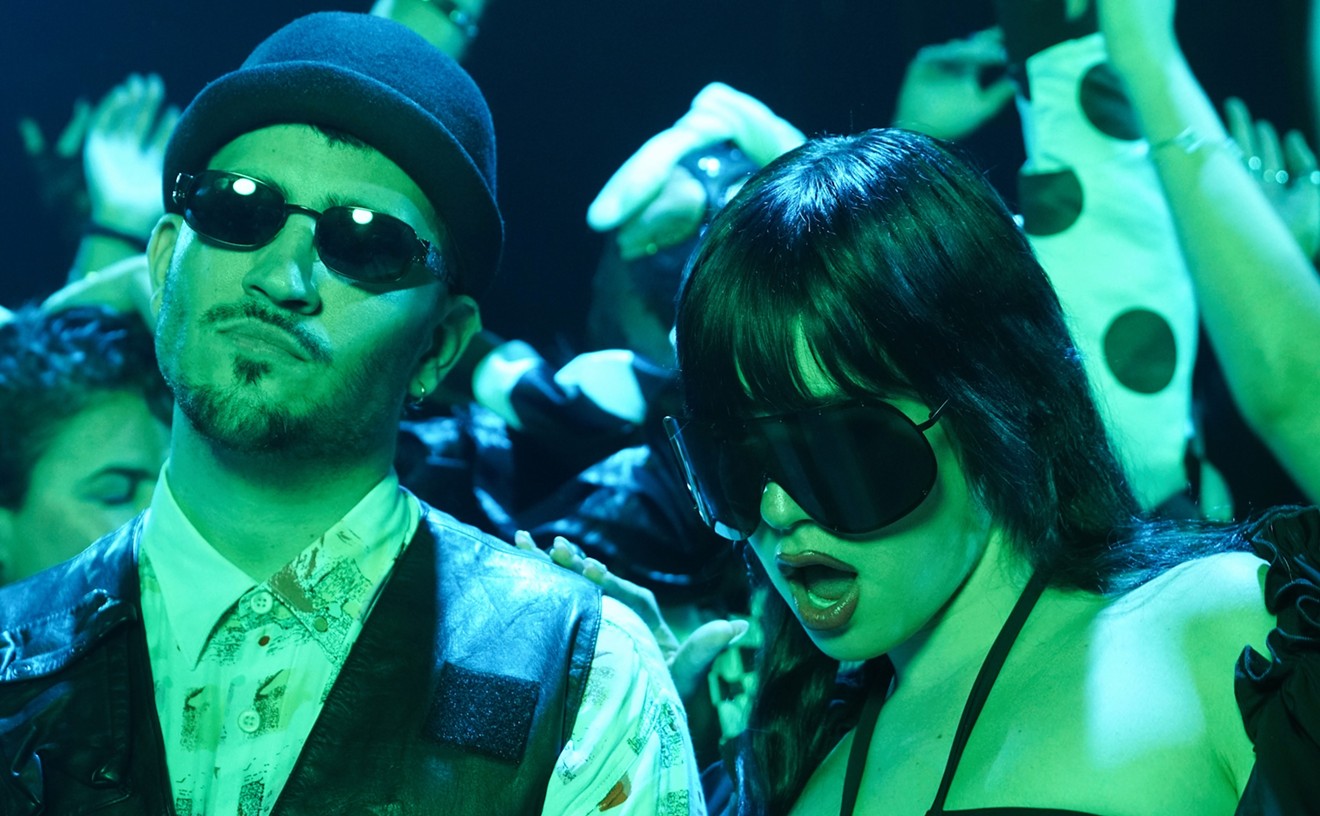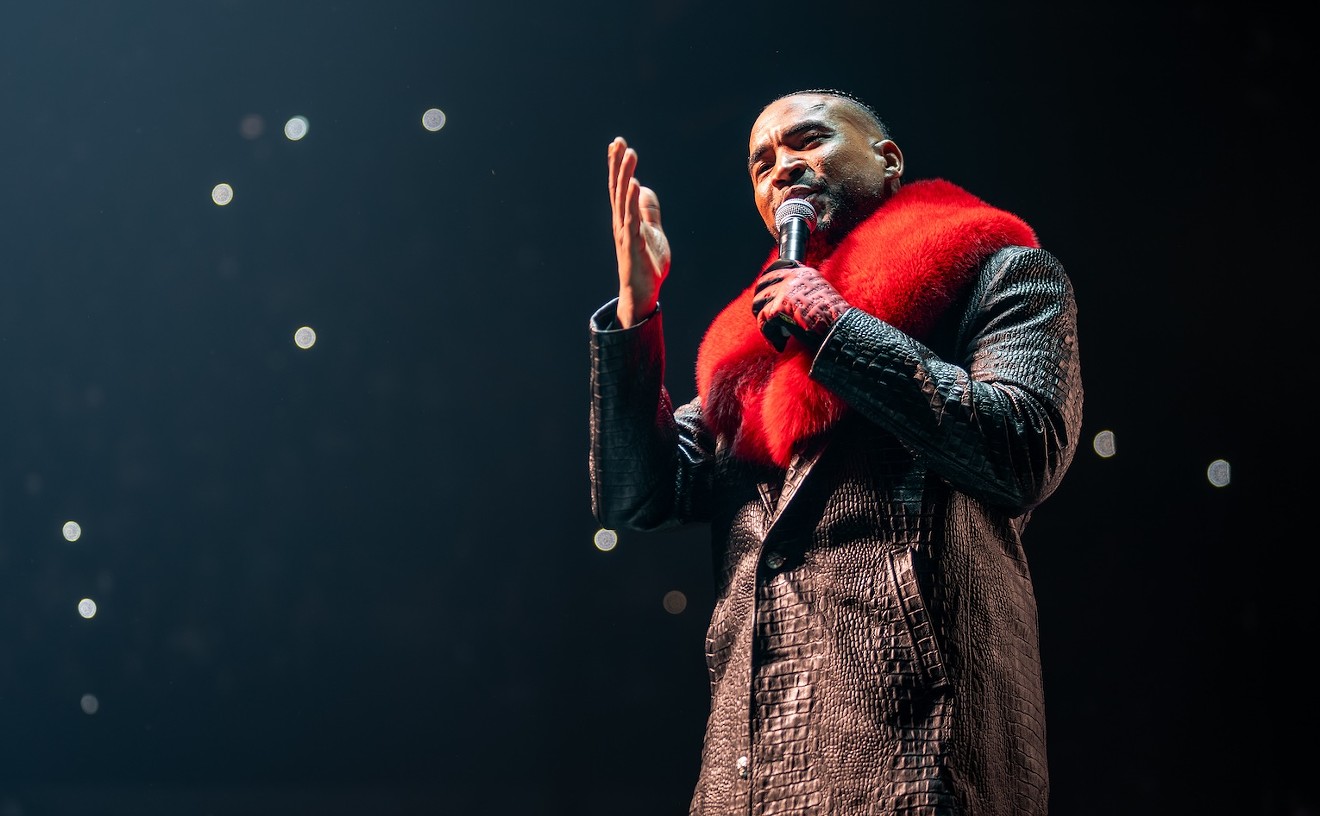Front 242 (Codenys plus Jean-Luc de Meyer, Richard Jonckheere, and Daniel Bressanutti) has devoted the past decade to taking the same juice that comes from our wall sockets -- what most people use to power toasters and blow driers -- and twisting it, manipulating it in their chambers of electronic torture to create distinct rhythms and melodies.
"There was a definite lack of musicians in Belgium," says Codenys of his homeland. "It wasn't as if one could get a bassist and a drummer together to form a band. So the temptation was great to work with machines."
More important for him was the discovery that "we were not limited to guitar sounds, or piano sounds. Our landscape encompassed everything within the sonic spectrum." This scope even translated to his day-to-day life. "If you keep your ears open on the city streets, you can hear thousands of sounds which can be manipulated to make music. Anything is a pretext to write a song. We'll start from a particular groove we like, or even from a line in a movie or on TV."
The electrogrooving began in 1982 when Codenys and techno wiz Bressanutti began to lay down ideas for an album. They recruited Jean-Luc de Meyer to record the vocals and Richard Jonckheere (then known as Richard 23) to add support to the band's live performances. From this unholy alliance Front 242 emerged and gave birth to its first demon -- Geography.
The Front 242 sound was modeled after the German anti-rock movement pioneered by artists such as Kraftwerk and Can. Bressanutti and Codenys, however, forged their own trail with the addition of Europop melodies and sociopolitical messages. These "collages," as Codenys refers to them, were logical offshoots of Bressanutti's and Codenys's design training and their experience with early computer equipment. It was audio artwork -- created to plow against the stale rock and roll that had entrenched itself in Europe at the time.
Their "electronic body music" soon caught the attention of clubgoers and the success of their subsequent albums and the singles secured Front 242 as the industrial-music pioneers of the Eighties. "Master Hit" and "Quite Unusual" -- from the Official Version album -- became staples at alternative dance clubs. "Welcome to Paradise," originally released as a b-side of the "Headhunter" single, stirred a craze with its tongue-in-cheek evangelical samples.
The latest 242 opus, a two-album series entitled 06:21:03:11 Up Evil and 05:22:09:12 Off (hey kids, it's an alphanumeric code A translate it and tell Jesse Helms that you saw it in a family newspaper) explores new directions for the band. That's a reaction A Codenys says the band wanted to get away from any sort of "trademark Front 242 Sound. That was the last thing we wanted, so we felt it was time to begin scouting the available avenues.
"On these albums, we've worked with ambiant music, hyper-distortion of vocals, and even female vocals to create an organized chaos which would break us away from our previous exercises in order and organization. These albums shouldn't be looked upon as a definite new direction, but rather an indication of where we can go."
Of course tastes vary and Codenys can see where dancing on the artistic razor's edge paid off and where it failed. If nothing else, the full experiment dramatically illustrates the artistic risks taken. And paradoxically enough, in trying to keep from becoming too commercial, Front 242 may have actually tapped a wider audience.
As with any artist, Codenys sees himself as an interpreter, translating feelings about the world into art. "But," he insists, "never in a way that is so obvious that it doesn't provoke thought." True to its electronic nature, the meaning in the music directly interfaces with the world in which the compositions are created. The obsessions and preoccupations of Western society are decoded, in real time, into grooves, beats, noise, and, sometimes, actual lyrics.
"Our earlier work was created in a time when East-West tensions were still high," Codenys offers. "These albums focused on this tension and on the media which brought that home to us. The albums were sarcastic in their presentation of the world."
Allegory became reality, though, during the Gulf War. "We saw an entire war created for the media," Codenys notes. "In essence, the ridiculous nature of what had been occurring throughout the Eighties was realized. We do not intend to offend anybody with cynicism, but sometimes there is no other way to paint an accurate picture."
With the new albums, Front 242 is taking on a more humanistic theme. "These works explore the extremes within man. We examine the evil and good within all -- the killer and the lover."
A nice thought, and the Front reflects this duality in the very styles of the two albums. Although Up Evil retains the characteristic beats and bass lines of the "Front 242 Sound," screaming guitar samples are rampant throughout, as are belligerent, super-distorted vocals. Not an appealing picture by description. But Codenys and the Front are able to carry out this anger and aggression in an aesthetically correct package that blends in some of the best melodies heard on any Front 242 album.
Off, on the other hand, makes extensive use of ambiant sounds that cast an eerie darkness on the mostly uptempo music, reminiscent of a Dario Argento horror film. The five original songs are rearranged and remixed to create a continuity and thematic recurrence usually associated with opera. Off does retain some of the bellicosity of its counterpart the distorted vocals are still present but the addition of female vocals on many tracks softens the rage.
The humanization of electronic music is also emphasized in the band's live performances, where Front 242 strives to dispel the traditional notion that electronic bands are cold and boring. Incorporating images and pictures as well as crosses and mirrors, the band stages something like chaotic hell. "Our set is based on a Hieronymus Bosch painting," Codenys explains. "Unfortunately, it is impractical to take too much on the road, so we were a bit limited."
Fortunately, the band is able to bring along enough stuff to avoid their previous inclusion of recorded tracks in the live show. "We're taking all our equipment with us. This time we'll be pushing 'start' instead of 'play'," jokes Codenys.
Still, there are those who firmly believe that electricity in music should be used only for Marshall amps. These folks may never cross over, but those who appreciate pulse and groove as well as those who prefer angry rock and roll will find solace in the new Front 242 creations.
It appears that, given the infinite possible permutations of zeros and ones, as well as the ease with which Codenys and Bressanutti are able to arrange them, the innovation in "electronic body music" will continue. Sometimes a light bulb just isn't enough.
Front 242, with Stabbing Westward and Ethyl Meatplow, performs at 8:00 p.m. Saturday at the Cameo Theatre, 1445 Washington Ave, Miami Beach, 532-0922. Tickets cost $17.50.










